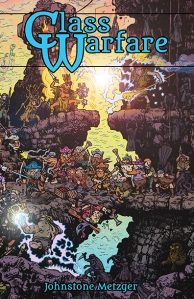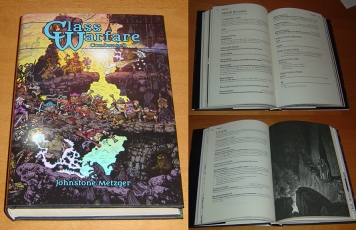Alternate Character and Class Creation Rules for Dungeon World
 What is Class Warfare?
What is Class Warfare?
Class Warfare is a rules supplement for the Dungeon World role-playing game that provides an alternate and expanded system of character creation. It can also be used to create new character classes, just like those provided in the original rulebook. How Class Warfare does this is by breaking down the Dungeon World character class into smaller pieces—like specialties and archetypes—and showing you how they fit together.
PRINT+PDF FROM DRIVETHRURPG
CONDENSED HARDCOVER VERSION FROM LULU
UPDATE: Class Warfare Condensed is the same book with a new, compact layout. When you buy the pdf, you get both versions, and all previous purchasers can download the new file from their library. It is also available in a hardcover format from Lulu (see link above) that comes with a dustjacket and lies flat on the table.
See a preview of the Rogues section HERE.
Specialties
A specialty is a collection of special abilities that describe one facet of what makes a character’s interaction with the rules of the game unique. Think of it as a shtick, perhaps, or a set of skills, even. Each specialty is approximately one-third of a normal Dungeon World character or character class. The Ranger, for example, is an archer, a hunter, and someone who has an animal companion—three special abilities. In Class Warfare terms, each of those is a specialty.
Archetypes
Each specialty is categorized into one of five different groups, called archetypes. These are general character “types,” that include: adventurer, disciple, magician, rogue, and warrior. Your archetype helps determine your damage die and your maximum hit points, and puts a few limits on which specialties you can combine together.
Basically, it means that if you focus on combat-oriented specialties, you end up with high damage and high hit points, which makes fighting an attractive option for you to take. If you focus on magical powers, you’re much less good at delivering blows or shrugging them off, even just using the basic moves. This encourages you to use your magic and stay out of fights.
Building a Character
You create a starting character by choosing an archetype and two or three specialties. But specialties can also be used as compendium classes, so there are ways to learn new abilities outside your original character concept if you undertake certain quests or perform certain feats. You are not limited only to the choices you made during character creation.
Why did I make this book?
To get rich, of course! Ah hahaha! So funny. In all seriousness, with Class Warfare, I had three primary goals: to make something that would be useful for both myself and other people in creating characters and in writing new classes; to give enough options that it could be used on its own and not just as an example of a new system; and to make it good for at least a little bit more than just initial character creation.
1. A Useful System of Doing Things
I wanted to build a system that breaks down class creation into small but logical pieces. This allows for more nuanced customization of existing character classes, and also gives people a way to make something new and unique that can be used in a game right away, without them having to tackle an entire class all at one time.
Hopefully, this system also gives people some insight into how the classes in Dungeon World balance spotlight time, effectiveness, and the number of moves characters have in relation to each other. Dungeon World is often less transparent than its parent, Apocalypse World, is in this regard, but a lot of people are coming to Dungeon World first, without any reference to other games that are “Powered by the Apocalypse.” Lots of rules design and play discussions that would help new players and GMs are scattered across various forums and private conversations, and aren’t easily accessible to people who weren’t there at the time. If this books can distil some of that knowledge and communicate it, great!
2. A Vast Array of Options
As much as I wanted the system to be easy, I also wanted it to provide plenty of options. The basic Dungeon World classes are already easy to use—the problem is that you only have eight options to choose from! Each of the five archetypes in Class Warfare has between 14 and 21 specialties to choose from, and you can also take one specialty from outside of your archetype. This alone leads to hundreds or even thousands of interesting characters. And then you can always write your own specialties, or ignore my archetypes altogether and build new custom classes out of whichever three archetypes you like. It’s not like I can stop you!
3. Utility Beyond Just Character Creation
I also wanted to encourage people to use these specialties as compendium classes, adding them to existing characters in the middle of play, or using them to extend a character’s game-life beyond level 10. That’s why I included fiction circumstances with each one that would allow you to add it to your character later. It’s only a little thing, but hopefully you find it useful or even inspiring.
How Complete or Definitive is Class Warfare?
Not at all! Just because this book is already super-thick doesn’t mean there aren’t tons more things that could be added to it. Most of the character class material from Dungeon World is included in this book. There’s a bunch of stuff from extras that Sage and Adam have made and some of the compendium classes that were included as kickstarter bonuses—mostly stuff that is available for free, just like Dungeon World itself is. There’s a good deal of my own previous material, including material from Ghostwood Haunts, Island of Fire Mountain, and Lair of the Unknown. Of course, it’s presented in a different format here, just like the material from Dungeon World.
I’ve also included a few moves from other third-party creators—but not a lot. If you want, sometime, I can tell you how I think the classes from Inverse World or Grim World break down into specialties and how you can use them with Class Warfare. But that material isn’t in this book, even though it’s creative commons. You should get it from the people who created it, not from me!
Also, I didn’t want to stray too far from core Dungeon World concepts. It’s true that many people get bored by the “D&D fantasy” genre, and you see new classes that feature drives and backgrounds, freeform spellcasting, or bonds with NPCs. But I wanted to stick to using alignments, Vancian spellcasting, and the four traditional fantasy races. Ultimately, with this book I’m just trying to add more options to the Dungeon World rules, not redefine how the game works. I can do that with other books, yet to be written. After all, this book isn’t supposed to be complete or definitive. Class Warfare is not a destination, it’s a departure point.
Class Warfare by the numbers:
670 starting moves and advanced moves, 227 race moves, 167 spells, 94 illustrations, 84 specialties, 3 different indexes.
$16 for the pdf via DriveThruRPG,
$28 for the print+pdf combo via DriveThruRPG (6×9, white pages, softcover, 526 pages),
$30 for the condensed layout in print from Lulu (6×9, cream-coloured pages, dustjacket, hardcover, 330 pages).
PRINT+PDF FROM DRIVETHRURPG
CONDENSED HARDCOVER VERSION FROM LULU
The pdf comes with a blank character sheet, but if you don’t like it, you should check out the sheet Brennen Reece made. If you like that one, also take a look at Brennen’s other Dungeon World character sheets.
There were some typos in the first version of the book! If you find one, please check the Errata List.


